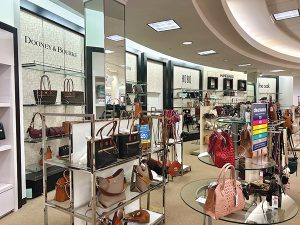The Supply Side: Consumers reduce spending on spring fashion
by April 14, 2025 11:03 am 989 views

Despite initial optimism, consumers polled by McKinsey & Company indicate they plan to spend less on discretionary categories like clothes and shoes over the next three months. Only 14% said they intend to spend more on apparel this spring.
A main reason for the spending pullback is consumers continue to spend more for food and necessary services. Just over a third of surveyed consumers reported mixed feelings about the economy, and pessimism ticked up slightly from the previous quarter. Half of consumers also said rising prices were their biggest worry. Notably, older consumers were more concerned about inflation compared with younger ones.
McKinsey said self-restraint seems to be replacing the holiday spending splurge for most consumers. The data indicated that a majority of consumers across all age groups plan to curb spending this spring.
“As we entered the new year, uncertainty was already a defining feature of the economic landscape — and it has only deepened in recent weeks,” said Kari Alldredge, partner at McKinsey. “While optimism about the economy has remained relatively high, spending intentions have declined, particularly for discretionary items. This decline was partly seasonal but also reflected growing unease about market conditions.”
She said weakening consumer confidence and sluggish retail sales reported in March are further indicators of more cautious spending habits. She said volatile financial markets — which are spooked by a tariff and trade war sparked by the Trump administration — of recent weeks only add to the concern.
 Consumers, particularly among Generation X (ages 46-60) and Generation Z (ages 18-28) respondents, said they planned to reduce spending on discretionary categories such as apparel, footwear and electronics, while they planned to increase spending on cruises and international flights compared with the previous quarter. Consumers do plan to vacation this year, and said they will reduce spending to make that happen.
Consumers, particularly among Generation X (ages 46-60) and Generation Z (ages 18-28) respondents, said they planned to reduce spending on discretionary categories such as apparel, footwear and electronics, while they planned to increase spending on cruises and international flights compared with the previous quarter. Consumers do plan to vacation this year, and said they will reduce spending to make that happen.
RETAILER CAUTION
Levi’s CEO Michelle Gass said recently that the denim brand is seeing consumers being more selective.
“I think in times like this, where there’s more pressure and more uncertainty, consumers also go to brands that they trust and that they love, and we’re one of those,” Gass said at a recent Shoptalk panel. “But it’s up to us. If the wallet’s tighter, then we have to work harder. We have to work harder in driving brand relevance. We’ve got to make sure that every single time they’re coming into one of our stores, it’s a phenomenal experience. And we’ve got to keep innovating and bringing them newness and things that they can’t resist buying. That’s our job.”
With consumer confidence hitting a 12-year low in March, Gass said the company remains focused on offering quality and durability.
Urban Outfitters executives recently reported a slowdown in sales for its biggest brands Anthropologie and Free People, and lower sales for the past 11 months of 2024 on a year-over-year basis. While the apparel retail conglomerate met expectations, its weaker forecast for 2025 sent the stock lower.
The same was true for Walmart, which exceeded earnings expectations but forecasted weaker growth this year because of reduced consumer spending and economic uncertainty related to tariff impacts. Data from CivicScience shows that 84% of Walmart consumers have reduced spending. More than 41% said they are reducing their spending on clothing, shoes and accessories in early 2025.
American Eagle CEO Jay Schottenstein noted a slow start to the year due to softer demand and weather-related impacts.
Kohl’s is forecasting between a 5% and 7% drop in net sales as it shutters underperforming stores. Even some off-price retailers are feeling the pinch. Ross Stores recently cited external volatility, and CEO Michael Conroy highlighted uncertainties in consumer demand, particularly in early 2025, which prompted a sales decline forecast between 1% and 2% in the first quarter.
The overall outlook for 2025 highlights a cautious industry stance, with most retailers preparing for potential economic pressures and fluctuating consumer spending.
LUXURY WOES
The pullback in spending is also happening among higher-income consumers shopping for luxury brands. Consumer Edge reports apparel, footwear, and accessories spending fell 2% in January and February, but luxury spending fell 7% from the year-ago period.
Consumer Edge found that spending on sports luxury footwear and athletic apparel fell 6% compared to the same period last year. Single-brand luxury sales also fell 6% compared to last year, which Consumer Edge said was despite positive performance from mid-level brands such as Coach and Ralph Lauren.
Customers reduced spending at higher-end brands, including Chanel and Christian Dior, for the second year in a row, which Consumer Edge said could be attributed to a potential protest against price hikes and limited product innovation. Among high-income shoppers, Gucci saw the worst share losses at Louis Vuitton and Cartier.
While all age groups reduced spending on apparel, accessories and footwear, consumers aged 25 to 34 cut back by 6.2% in the first two months of this year, the most over the last 12 months. Consumers older than 65 cut spending by 4.5% from a year ago. Those aged 35 to 44 decreased spending 4%, people aged 45 to 54 decreased spending 5%, and those aged 55 to 64 decreased spending 3.8%, according to the Consumer Edge data.
Editor’s note: The Supply Side section of Talk Business & Politics focuses on the companies, organizations, issues and individuals engaged in providing products and services to retailers. The Supply Side is managed by Talk Business & Politics, and is sponsored by HRG.
